Related Products
For Professionals
- Amplification
- Assessment of Student Skills, Challenges, Needs
- Early Childhood: Infants, Toddlers, Preschool
- Hearing Loss – Identification, Impact and Next Steps
- IDEA Law Summary Information
- Language and Speech Development Issues
- Legal Issues in Serving Children with Hearing Loss
- Listening (Auditory Skills) Development
- Planning to Meet Student Needs
- Self-Advocacy Skills for Students with Hearing Loss
- Self-Concept: How the Child with Hearing Loss Sees Himself
- Social Skills
- Speech Perception & Learning
Related Teacher Tools Takeout Items
Hearing Aids
Hearing aids amplify sound but they can also process the sound input so that the child will benefit more from what he or she hears. As a result of very extensive research and development, hearing aid technology has improved greatly in the ability to process sound not only in a quiet setting, but also in settings where some noise is present.
U.S. Law Requires Routine Checking of Hearing Devices
https://sites.ed.gov/idea/regs/b/b/300.113
(a) Each public agency must ensure that hearing aids worn in school by children with hearing impairments, including deafness, are functioning properly.
(b) (1) Each public agency must ensure that the external components of surgically implanted medical devices are functioning properly.
Example Amplification Monitoring Consent Form (PDF) (Contributed by Todd Ericksen, Ed Aud)
Webpages in this section:
Expectations for Caring for Hearing Devices
Strategies for Keeping Hearing Aids on Young Children
Student Materials for Learning About Hearing Loss & Hearing Aids
Evolution of the Hearing Aid -fun info to share with students!
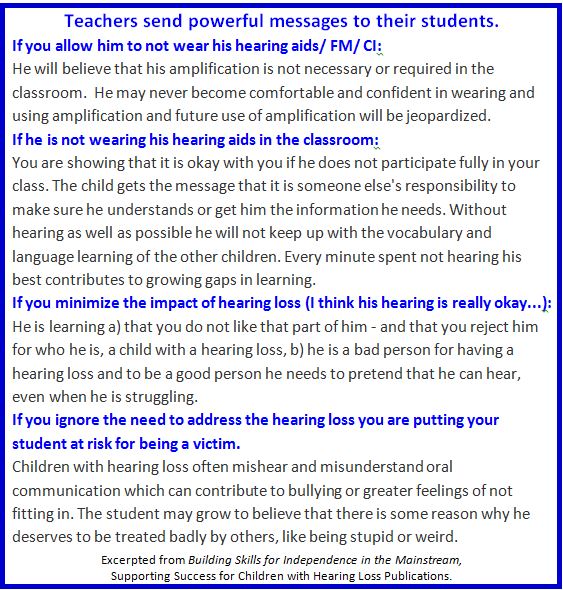
Understanding Your Student’s Hearing Using the DSL Approach
Resources for Families:
Attitude-is-Caught-Not-Taught – Parents actions speak louder than their words
Does he have to wear his hearing aids? Really? He seems to hear okay!
HEARING AIDS – What, When, Why, How
Important Facts About Hearing Aid Batteries – usage, expected life, needed care.
Central Institute for the Deaf (CID) QUICK TIPS – Hearing Aid Components
Central Institute for the Deaf (CID) QUICK TIPS – Troubleshooting Hearing Aids
What’s New in Hearing Aids for Kids?
In 2013 the American Academy of Audiology published updated practice guidelines for audiologists who fit hearing instruments on children (American Academy of Audiology (2013). Clinical Practice Guidelines on Pediatric Amplification). What’s different in these guidelines is:
 a) Light noise reduction may be used in the hearing aid prescriptive settings for children (as noise gets louder the loudness of the hearing aid is decreased and ‘shaped’ so that understanding speech is maximized).
b) Adaptive directionality may be used (program the hearing aid so it can ‘listen’ from varying directions).
c) Digital feedback management may be used (hearing aid program to stop hearing aid whistling).
a) Light noise reduction may be used in the hearing aid prescriptive settings for children (as noise gets louder the loudness of the hearing aid is decreased and ‘shaped’ so that understanding speech is maximized).
b) Adaptive directionality may be used (program the hearing aid so it can ‘listen’ from varying directions).
c) Digital feedback management may be used (hearing aid program to stop hearing aid whistling).
These features were not recommended previously because it was thought that they would reduce the amount of amplification (or gain in loudness) of the hearing aids in some situations (e.g., directional microphones could conceivably decrease the child’s ability to hear sounds coming from behind them). Recent research has shown that these features are generally helpful, comfortable, and most children from a young age are able to benefit from them. Use of these features should be considered for each child on a case-by-case basis, and should depend on the age of the child, the degree and shape of the audiogram, and other factors. Many states, clinics or hearing aid dispensaries have their own guidelines which further define the AAA 2013 Amplification Guidelines. Check with your state or dispensary see if you can obtain a copy of their amplification guidelines.
Squishing the better hearing into the poorer hearing pitch range:
Frequency lowering is a way to treat the hearing loss in the frequency or pitch domain as well as the amplification (gain or loudness) domain. This feature is most often used for high frequency hearing losses or for severe-to-profound flat hearing losses. Most audiologists agree that frequency lowering should only be used where audibility for certain high frequency speech sounds cannot be demonstrated (e.g., /sss/ or /shhh/) with other types of hearing aids.
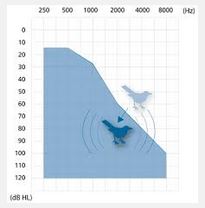 Frequency lowering attempts to provide added high frequency information (including bird songs and other environmental sounds) by taking the in-coming high pitch sounds and lowering them into regions on the audiogram where the child’s hearing is better able to use the information from those sounds. There are a couple of ways that hearing aids can do this:
Frequency lowering attempts to provide added high frequency information (including bird songs and other environmental sounds) by taking the in-coming high pitch sounds and lowering them into regions on the audiogram where the child’s hearing is better able to use the information from those sounds. There are a couple of ways that hearing aids can do this:
a) Frequency transposition effectively cuts off the amplification at a pitch or frequency where the child’s hearing may not be able to hear or use those sounds, even when he is amplified (i.e., the sensory hair cells in the cochlea may not be responsive to sounds in that frequency region). The octave or two of those high frequency sounds is laid down over the octave below it, where the child may have better hearing function. b) Frequency compression “squishes” the higher frequency information into the lower frequency region, also using a cut-off frequency on the audiogram.
Hearing aids are getting smaller
Some are called “mini” or “micro” style behind-the-ear (BTE) hearing aids. These may help with the fit of hearing aids on very tiny baby ears. It also helps with some parents’ or family members’ who think it is important to have cosmetically discreet hearing devices. Mini or micro BTE hearing aids can be fit with:
 a standard (traditional) earhook and standard custom earmold with standard polyethylene tubing
a standard (traditional) earhook and standard custom earmold with standard polyethylene tubing- a slimtube with a custom slimtip OR a disposable silicone dome (open, closed, sleeve, plus, power, bass) (example – blue hearing aids below)
- a canal receiver (CR, also called a thinwire, or RIC (receiver-in-the-canal) or RITE (receiver-in- the-ear)) (example – black hearing aid below)
Pros:
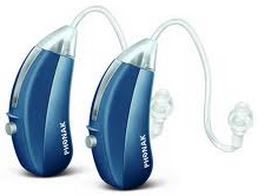 Tiny, discreet instrument,
Tiny, discreet instrument,- Lightweight
- may fit baby’s or small child’s ear better
- Canal receivers can usually be changed out in the hearing aid dispenser’s office rather than sending in for repair
- Several power levels may be available, so if the hearing levels change the thinwire can generally be changed out at a nominal charge to accommodate the change in hearing
- Older kids often like these hearing aids due to their high-tech look (often they look like blue-tooth on-ear wireless phone devices) or they may be very hard to see at all
Cons:
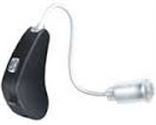 Insisting on a tiny hearing aid size may send the message to the child that they will not be liked if people knew they had a hearing loss (they should be ashamed of the hearing loss and hide it)
Insisting on a tiny hearing aid size may send the message to the child that they will not be liked if people knew they had a hearing loss (they should be ashamed of the hearing loss and hide it)- These small hearing aids may not be available in all power levels or appropriate to fit to all hearing losses
- These tiny hearing aids may be easier to lose and will be harder to find if they are lost or misplaced
- Due to their small size, they may not have locking battery doors (so inappropriate in early childhood)
- Due to their small size, they may have fewer (or no) on-board user controls (so small, but not as ‘tunable’ to meet the child’s needs)
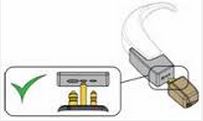 There may be problems connecting these small hearing aids with other hearing devices needed at school:
There may be problems connecting these small hearing aids with other hearing devices needed at school:
- Most kids’ hearing aids are set for automatic function (automatic volume adjustment, automatic program change) BUT
- Some schools want separate programs (e.g., FM, FM+M, T, MT, Streaming) for use with their wireless hearing assistance technologies (HAT) to improve communication access in large or noisy classrooms (more on this later
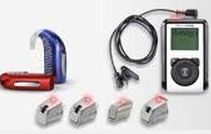 Due to their small size, they may or may not offer all wireless connectivity options
Due to their small size, they may or may not offer all wireless connectivity options
- Many of the mini or micro hearing aids do not have a DAI (direct audio input) option which would be needed for direct connection with an FM system
- Most can have a T (telecoil) program option, or MT (microphone and telecoil) program option needed for using a land-line telephone (babies “talk” to Daddy or Grandma on the phone beginning shortly after birth!)
- They can be used with an induction-type neck loop receiver for an FM system (e.g., Phonak myLink+, Widex T-Dex)
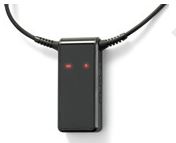 Many have a Bluetooth streaming option. In this mode, a Bluetooth transceiver or receiver is also needed to receive the bluetooth signal from a remote audio source. This may be a Bluetooth neckloop (suitable for children 5+ years old, on a case-by-case basis), which can accept an FM receiver for use with an FM teacher microphone/transmitter, or can be used directly with a Bluetooth remote (or “partner”) microphone
Many have a Bluetooth streaming option. In this mode, a Bluetooth transceiver or receiver is also needed to receive the bluetooth signal from a remote audio source. This may be a Bluetooth neckloop (suitable for children 5+ years old, on a case-by-case basis), which can accept an FM receiver for use with an FM teacher microphone/transmitter, or can be used directly with a Bluetooth remote (or “partner”) microphone
SOME GENERAL CONSIDERATIONS ABOUT HEARING AIDS AND KIDS:
 Candidacy (not all hearing aids will fit all levels or types of hearing loss – not all kids can get ‘cute’ aids)
Candidacy (not all hearing aids will fit all levels or types of hearing loss – not all kids can get ‘cute’ aids)- Physical characteristics of the hearing aids (they need to match the child’s needs – really!)
- Wireless access (our world is becoming ever more connected – kids need to connect in many ways)
- Electroacoustic characteristics (‘cute’ should NEVER be chosen over an aid that truly meets hearing needs)
- Orientation and care and maintenance (dedicated time is needed daily by the adults in the child’s life)
- School services (if the new hearing aids don’t ‘match’ the type of FM used in school, the school may have to provide hearing aids for the child – meaning ‘different’ hearing quality at home and at school to challenge the listening brain)
- Validation (showing that the hearing aid is benefitting the child as much as expected)
- Follow-up (the ‘best’ audiologist is one who knows the child’s true needs and can respond quickly when issues arise)
With great appreciation, the information “What’s New in Kid’s Hearing Aids?” was written by Vicki Anderson, AuD, educational and pediatric audiologist, Minneapolis MN. This information was posted August 2014.
Printed version of this information

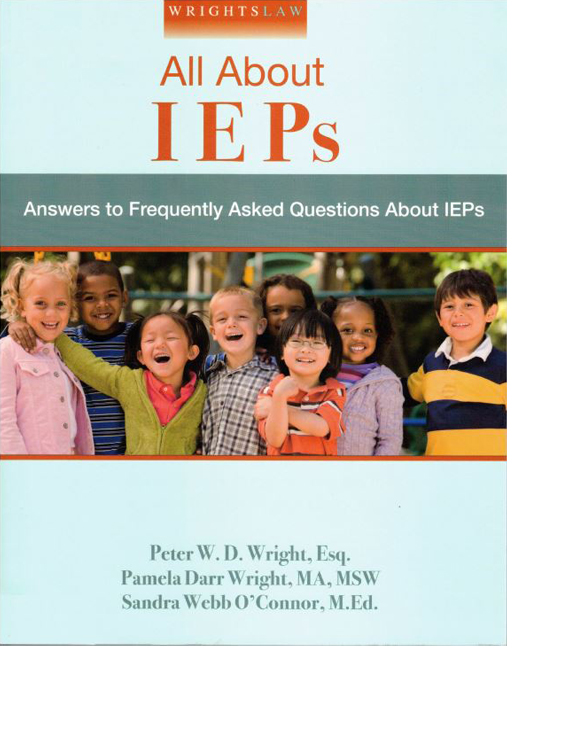



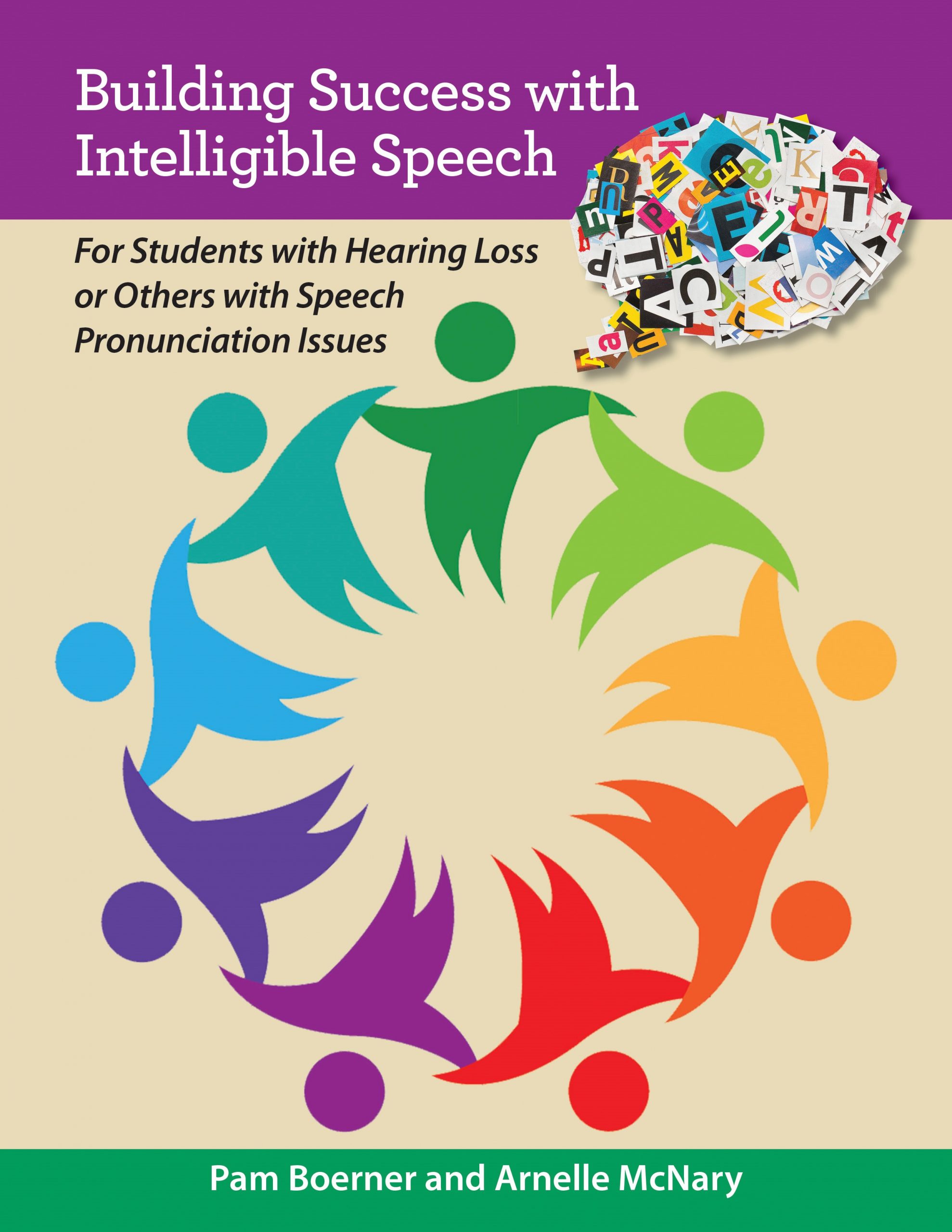
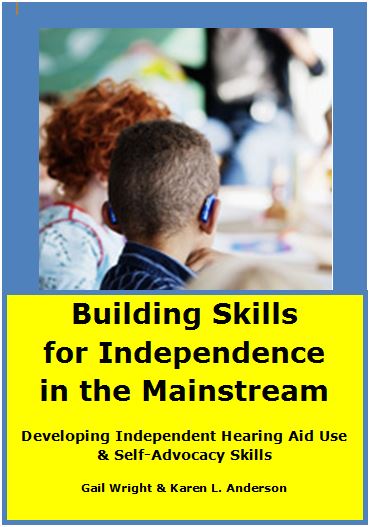
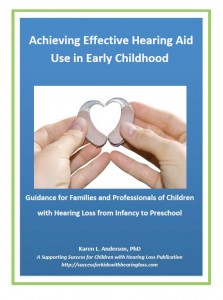

 Hearing Aids and Your Child
Hearing Aids and Your Child